Unit 3 Is this your pencil ?语法精析精练 (含答案)
文档属性
| 名称 | Unit 3 Is this your pencil ?语法精析精练 (含答案) |  | |
| 格式 | zip | ||
| 文件大小 | 1.2MB | ||
| 资源类型 | 试卷 | ||
| 版本资源 | 人教新目标(Go for it)版 | ||
| 科目 | 英语 | ||
| 更新时间 | 2021-07-04 07:21:01 | ||
图片预览



文档简介
中小学教育资源及组卷应用平台
七上Unit
3语法精析精练
语法精析
名词性的物主代词
(一)名词性的物主代词起名词的作用。
1.
Look
at
the
two
pencils.
The
red
one
is
yours
and
the
blue
one
is
mine.
看那两支铅笔,红的是你的,蓝的是我的
2.
He
likes
my
pen.
He
doesn't
like
hers.
他喜欢我的钢笔。不喜欢她的。
注意:在使用名词性的物主代词时,必须有特定的语言环境,也就是要省略的名词大家已经知道,已经提起过.
例如:
There
is
a
book
on
the
desk..lt'
s
hers.书桌上有本书。是她的。(先提及,大家才明白)
为避免重复使用名词,有时可用“名词性的物主代词”来代替“形容词性的物主代词+名词”
My
bag
is
yellow,
her
bag
is
red,
his
bag
is
blue
and
your
bag
is
pink.
为避免重复使用bag,上句可写成
My
bag
is
yellow,.
hers
is
red,
his
is
blue
and
yours
is
pink.
(二)名词性物主代词的句法功能。
1.作主语,例如:
May
I
use
your
pen?
Yours
works
better.
我可以用一用你的钢笔吗?你的比我的好用。
2.作宾语,例如:
I
love
my
motherland
as
much
as
you
love
yours.
我爱我的祖国就像你爱你的祖国一样深。
附一:
物主代词“形”变“名”歌
形物代变名物代
掌握规律变得快
多数词尾加s
my,its,his要除外
my把y来变成
接着再把me带
his,its不用变
词形一样莫奇怪
附二:
反身代词变化歌
反身代词代自己
懂得规律很好记
单数人称加self
复数人称
selves
二人称都一样
所有格后加“自己
第三人称不一样
要用宾格加“自己”
一般疑问句
(一)一般疑问句的结构
一般疑问句有两个家族。
第一家族为含be动词或情态动词的一般疑问句,其结构为:be+主语+其他部分?
情态动词十主语十动词原形+其他部分?
肯定回答用“Ye,主语+be/情态动词”,否定回答用“No,主语+be情态动词+not。be或情态动词和not可用缩写形式主要有isnt,
aren't,.can't,
mustn''t,
needn''t等。
例如:
1.
-Is
this
your
English
book??
-Yes,
it
is.
,
it
isn't..
2.-Are
these
your
English
books?
-Yes,
they
are.
,
they
aren't.
3.-Can
you
speak
English?
-Yes,
I
can.
,
I
can't.
另一家族为含行为动词(或称为实义动词)的一般疑问句其结构为:助动词十主语+动词原形+其他?
肯定回答用“Yes,主语+do/does.”,否定回答用“No,主语+do/
does
not..”。助动词也常用缩写形式,主要有don't,doesn't等。
例如:
Do
your
parents
like
English??
-Yes,
they
do.
,
they
don't.
一般疑问句的回答
正如前面所述,回答一般疑问句时有肯定回答和否定回答两种方式,肯定回答以Yes起句,否定回答用No开头。但对一般疑同句的回答也不是一成不变的。肯定回答还可以用OK,Certainly..等;否定回答可用
Sorry../
Sorry,,
I
can't..等。
例如:
Can
you
speak
English?
Certainly.
/Sorry,
I
can't.
(三)一般疑问句的语调
朗读一般疑问句时用升调,而一般疑问句的简略答语则用降调。
(四)如何将陈述句变为一般疑问句?
根据一般疑问句不同的家族,可以用不同的方法将陈述句变为相应的一般疑问句
第一家族:含be动词或情态动词的句子
秘诀:一调二改三问号
一调:即把句中的be动词或情态动词调到主语前;
二改:改换称谓,即将句中的
I
my
mine
we
our
ours等第一人称分别改为相应的第二人称
you
your
yours等
三问号:句末的句号改为问号。
例如:
(1)I
am
an
English
teacher.
-Are
you
an
English
teacher?
(2)
We
can
speak
English
fluently.
--Can
you
speak
English
fluently?
2.第二家族:含行为动词(或称为实义动词)的句子
秘诀:一加二改三问号
一加:即在句首加助动词Do或Does
二改:(1)把谓语动词改为原形:(2)改换称谓(同第一家族)
三问号:句末的句号改为问号
(1)
We
read
English
every
morning.
--Do
you
read
English
every
morning?
(2)Tom's
father
listens
to
English
on
the
radio
every
morning.
Does
Tom's
father
listen
to
English
on
the
radio
every
morning?
特别注意:对于第二家族一定要注意动词的还原,因为时与数的变化已经体现在助动词上了。
语法精练
1.用所给词的适当形式填空。
1.
This
book
is
not
__________.(I)
2.
Look
at
__________mouth.
(I)
3.
They
are
__________parents.(he)
4.
__________these
your
books?
(be)
5.
Your
school
is
newer
than
__________.(he)
6.
__________classroom
is
bright((明亮).(I)is
brighter
than
__________(she,I)
7.
He
is
__________father.(Bob)
8.
Thank
you
for
__________me.
(help)
9.
This
isn't
__________pen.
__________is
over
there.
(she,
she)
10.
__________school
is
far
away
from(远离)
__________home.(he)
Ⅱ.句型转换。
1.
This
is
my
notebook..(改为一般疑问句)
__________this
__________notebook?
2.
That
is
a
watch..(对划线部分提问)
__________that?
3.
His
name
is
Tim..(对划线部分提问)
__________his
name?
4.
There
are
some
books
in
the
schoolbag..(改为一般疑问句)
__________there
__________books
in
the
schoolbag?
5.
She
is
Li
Ping..(写出同义句
__________
__________is
Li
Ping.
答案
语法精练
I.
1.
mine
2.
my
3.
his
4.
Are
5.his
6.My,hers,mine
7.
Bob's
8.
helping
9.
her,
Her.
10.His,
his
II.
.
1.
Is,
your
2.
What's
3.
What's
4.Are,any
5.
Her
name
HYPERLINK
"http://21世纪教育网(www.21cnjy.com)
"
21世纪教育网(www.21cnjy.com)
七上Unit
3语法精析精练
语法精析
名词性的物主代词
(一)名词性的物主代词起名词的作用。
1.
Look
at
the
two
pencils.
The
red
one
is
yours
and
the
blue
one
is
mine.
看那两支铅笔,红的是你的,蓝的是我的
2.
He
likes
my
pen.
He
doesn't
like
hers.
他喜欢我的钢笔。不喜欢她的。
注意:在使用名词性的物主代词时,必须有特定的语言环境,也就是要省略的名词大家已经知道,已经提起过.
例如:
There
is
a
book
on
the
desk..lt'
s
hers.书桌上有本书。是她的。(先提及,大家才明白)
为避免重复使用名词,有时可用“名词性的物主代词”来代替“形容词性的物主代词+名词”
My
bag
is
yellow,
her
bag
is
red,
his
bag
is
blue
and
your
bag
is
pink.
为避免重复使用bag,上句可写成
My
bag
is
yellow,.
hers
is
red,
his
is
blue
and
yours
is
pink.
(二)名词性物主代词的句法功能。
1.作主语,例如:
May
I
use
your
pen?
Yours
works
better.
我可以用一用你的钢笔吗?你的比我的好用。
2.作宾语,例如:
I
love
my
motherland
as
much
as
you
love
yours.
我爱我的祖国就像你爱你的祖国一样深。
附一:
物主代词“形”变“名”歌
形物代变名物代
掌握规律变得快
多数词尾加s
my,its,his要除外
my把y来变成
接着再把me带
his,its不用变
词形一样莫奇怪
附二:
反身代词变化歌
反身代词代自己
懂得规律很好记
单数人称加self
复数人称
selves
二人称都一样
所有格后加“自己
第三人称不一样
要用宾格加“自己”
一般疑问句
(一)一般疑问句的结构
一般疑问句有两个家族。
第一家族为含be动词或情态动词的一般疑问句,其结构为:be+主语+其他部分?
情态动词十主语十动词原形+其他部分?
肯定回答用“Ye,主语+be/情态动词”,否定回答用“No,主语+be情态动词+not。be或情态动词和not可用缩写形式主要有isnt,
aren't,.can't,
mustn''t,
needn''t等。
例如:
1.
-Is
this
your
English
book??
-Yes,
it
is.
,
it
isn't..
2.-Are
these
your
English
books?
-Yes,
they
are.
,
they
aren't.
3.-Can
you
speak
English?
-Yes,
I
can.
,
I
can't.
另一家族为含行为动词(或称为实义动词)的一般疑问句其结构为:助动词十主语+动词原形+其他?
肯定回答用“Yes,主语+do/does.”,否定回答用“No,主语+do/
does
not..”。助动词也常用缩写形式,主要有don't,doesn't等。
例如:
Do
your
parents
like
English??
-Yes,
they
do.
,
they
don't.
一般疑问句的回答
正如前面所述,回答一般疑问句时有肯定回答和否定回答两种方式,肯定回答以Yes起句,否定回答用No开头。但对一般疑同句的回答也不是一成不变的。肯定回答还可以用OK,Certainly..等;否定回答可用
Sorry../
Sorry,,
I
can't..等。
例如:
Can
you
speak
English?
Certainly.
/Sorry,
I
can't.
(三)一般疑问句的语调
朗读一般疑问句时用升调,而一般疑问句的简略答语则用降调。
(四)如何将陈述句变为一般疑问句?
根据一般疑问句不同的家族,可以用不同的方法将陈述句变为相应的一般疑问句
第一家族:含be动词或情态动词的句子
秘诀:一调二改三问号
一调:即把句中的be动词或情态动词调到主语前;
二改:改换称谓,即将句中的
I
my
mine
we
our
ours等第一人称分别改为相应的第二人称
you
your
yours等
三问号:句末的句号改为问号。
例如:
(1)I
am
an
English
teacher.
-Are
you
an
English
teacher?
(2)
We
can
speak
English
fluently.
--Can
you
speak
English
fluently?
2.第二家族:含行为动词(或称为实义动词)的句子
秘诀:一加二改三问号
一加:即在句首加助动词Do或Does
二改:(1)把谓语动词改为原形:(2)改换称谓(同第一家族)
三问号:句末的句号改为问号
(1)
We
read
English
every
morning.
--Do
you
read
English
every
morning?
(2)Tom's
father
listens
to
English
on
the
radio
every
morning.
Does
Tom's
father
listen
to
English
on
the
radio
every
morning?
特别注意:对于第二家族一定要注意动词的还原,因为时与数的变化已经体现在助动词上了。
语法精练
1.用所给词的适当形式填空。
1.
This
book
is
not
__________.(I)
2.
Look
at
__________mouth.
(I)
3.
They
are
__________parents.(he)
4.
__________these
your
books?
(be)
5.
Your
school
is
newer
than
__________.(he)
6.
__________classroom
is
bright((明亮).(I)is
brighter
than
__________(she,I)
7.
He
is
__________father.(Bob)
8.
Thank
you
for
__________me.
(help)
9.
This
isn't
__________pen.
__________is
over
there.
(she,
she)
10.
__________school
is
far
away
from(远离)
__________home.(he)
Ⅱ.句型转换。
1.
This
is
my
notebook..(改为一般疑问句)
__________this
__________notebook?
2.
That
is
a
watch..(对划线部分提问)
__________that?
3.
His
name
is
Tim..(对划线部分提问)
__________his
name?
4.
There
are
some
books
in
the
schoolbag..(改为一般疑问句)
__________there
__________books
in
the
schoolbag?
5.
She
is
Li
Ping..(写出同义句
__________
__________is
Li
Ping.
答案
语法精练
I.
1.
mine
2.
my
3.
his
4.
Are
5.his
6.My,hers,mine
7.
Bob's
8.
helping
9.
her,
Her.
10.His,
his
II.
.
1.
Is,
your
2.
What's
3.
What's
4.Are,any
5.
Her
name
HYPERLINK
"http://21世纪教育网(www.21cnjy.com)
"
21世纪教育网(www.21cnjy.com)
同课章节目录
- starters 预备篇(2012秋审查)
- Unit 1 Good morning !
- Unit 2 What’s this in English?
- Unit 3 What color is it ?
- Unit 1 My name's Gina.
- Section A
- Section B
- Unit 2 This is my sister.
- Section A
- Section B
- Unit 3 Is this your pencil?
- Section A
- Section B
- Unit 4 Where's my schoolbag?
- Section A
- Section B
- Unit 5 Do you have a soccer ball?
- Section A
- Section B
- Unit 6 Do you like bananas?
- Section A
- Section B
- Unit 7 How much are these socks?
- Section A
- Section B
- Unit 8 When is your birthday?
- Section A
- Section B
- Unit 9 My favorite subject is science.
- Section A
- Section B
